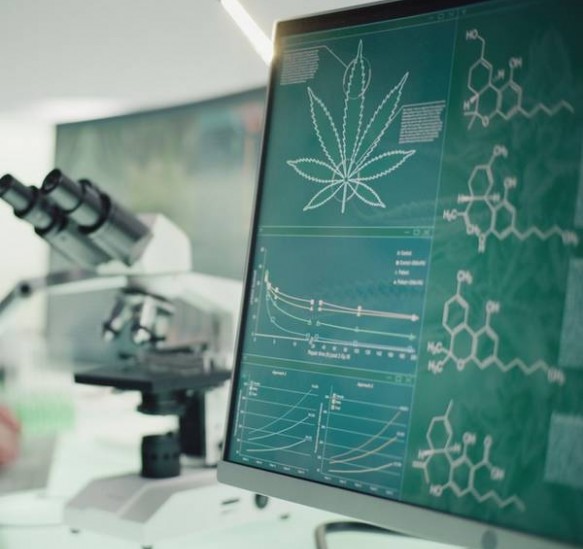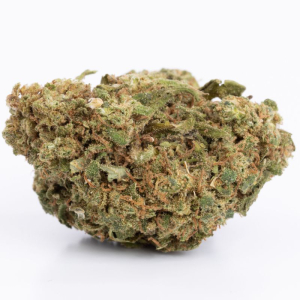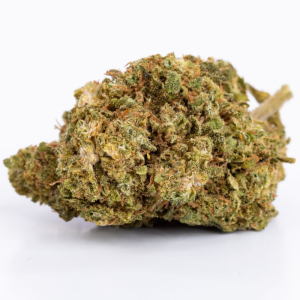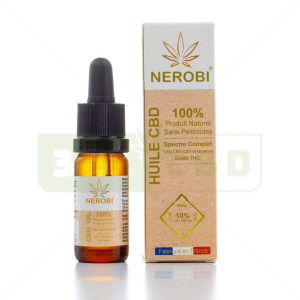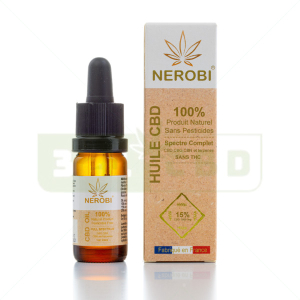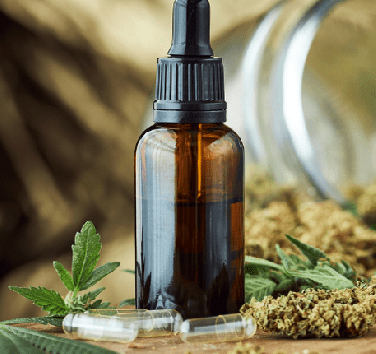What is THCP?
THCP, or tetrahydrocannabiphorol for the bravest, is part of this wave of cannabinoids recently discovered in the hemp plant, in this case Cannabis L. Sativa, a variety known for its stimulating properties, its action on motivation, concentration and memorization and its analgesic properties.
Discovering THCP: thanks to science!
It was therefore in 2019 that a team of Italian researchers was able to highlight the natural presence of THCP in the cannabis plant as part of an in-depth scientific research aimed at discovering and analyzing the cannabinoids hitherto unknown by mobilizing new techniques in the field of hemp research.
Result of the races: two "new" molecules were isolated for the first time in the laboratory, CBDP and THCP. In detail, these discoveries were made using a variety of advanced chemical analysis techniques, including high performance liquid chromatography (HPLC) and high resolution mass spectrometry (HRMS).
Note: the cannabis plant has more than a hundred different cannabinoids, and many are still poorly understood or even completely unknown to the scientific community, especially those that display a long chain molecular structure. In many ways, the cannabis plant will continue to fuel scientific discovery for many years to come. And you can count on 321CBD to echo it and inform you!
THCP: what is the chemical structure of this newly isolated cannabinoid?
THCP is a phytocannabinoid, in the sense that it is a cannabinoid produced naturally by the cannabis plant, as opposed to synthetic cannabinoids produced by humans in vitro . Its structure is very close to delta-9-tetrahydrocannabinol, better known by the acronym THC, the most famous and abundant cannabinoid in the cannabis plant and which gives it its psychotropic and addictive effects.
THCP and THC consist of a resorcinol unit (an aromatic organic compound) linked to a long chain of alkyls by a monoterpene unit. But there is a "big" difference: THCP's alkyl chain is longer than THC's, with seven carbon atoms (heptyl) instead of THC's five (pentyl). This difference may seem trivial but in reality it has a very significant impact on the way THCP interacts with the endocannabinoid system (ECS) of the human body.
So much for the brief history of THCP, a cannabinoid discovered in 2019 which continues to be the subject of substantial research activity to better understand its effects and its medical applications, but also in the world of well-being. and relaxation.
.png)
THCP: how does this cannabinoid interact with the endocannabinoid system?
To begin to understand the potential action of THCP on our body, we must first understand what the endocannabinoid system is. In truth, any consumer of CBD and non-psychotropic cannabinoids should be interested in the ECS, because it explains much of the action of legal hemp on our daily well-being. Here we go!
What is the endocannabinoid system (ECS)?
The endocannabinoid system is a complex cellular communication system that is involved in the regulation of many body functions, including the sensation of pain, mood, appetite, metabolism, sleep, memory and the immune response. Does that remind you of anything? This is more or less the scope of action of cannabidiol and other cannabinoids of the hemp plant, Sativa as well as Indica.
Again, we're on to a recent discovery, as ECS was first described in the mid-1990s...but scientists have always "suspected" its existence by observing the effects of hemp consumption on the body. body and mind. To fully understand how the ECS works, let's look at its three main components and their role in the body:
- Cannabinoid receptors: The two main cannabinoid receptors known to the scientific community are "CB1" and "CB2". CB1 receptors are very present in the brain and the central nervous system, but they are also found, to a lesser extent, in the skin and in certain parts of the body which seem to vary from one individual to another. CB2 receptors are most common in the immune system, bone marrow cells, and blood cells;
- Endocannabinoids: These are chemical compounds naturally produced by the human body that bind to cannabinoid receptors. To simplify, these are cannabinoids produced not by the hemp plant, but by our body. The two most studied endocannabinoids are anandamide (AEA) and 2-arachidonoylglycerol (2-AG);
- Enzymes: these will synthesize and degrade endocannabinoids. The two best-known enzymes are the endocannabinoid synthesis enzyme (NAPE-PLD for anandamide and DAGL for 2-AG) and the endocannabinoid degradation enzymes (FAAH for anandamide and MAGL for 2-AG ).
What role does ECS play in the body?
The endocannabinoid system is what is known as a regulator of homeostasis. In simpler terms, it helps the body maintain its internal balance in response to the various changes that may occur in its microenvironment (stimuli). ECS is involved in a huge number of physiological processes, including pain control, inflammation, memory, mood, sleep, metabolism, nervous system protection, immune response, and even human reproduction. .
When an imbalance is detected (stress and anxiety, pain, inflammation, dietary imbalance such as fasting or overeating, lack of sleep, etc.), the endocannabinoid system kicks into action. How ? Endocannabinoids are produced on demand, traveling backwards through synapses to regulate cellular activity and restore balance. Wonderful, right? Now let's see the potential place of THCP in this symphony.
.png)
THCP and the endocannabinoid system: what we know
While the study of THCP is still in its infancy, this newly discovered cannabinoid has already shown promising potential in the way it interacts with the endocannabinoid system.
As explained above, the endocannabinoid system is mainly composed of two types of receptors (CB1 and CB2) scattered throughout the body and receptive to the effects of cannabinoids. THC, the best-known cannabinoid, displays a high affinity with the CB1 receptor, which is particularly concentrated in the brain. And this explains the psychotropic effects of THC. On the other hand, CBD and other non-psychotropic cannabinoids are hardly attracted to CB1 receptors, which explains the absence of psychotropic effect and risk of severe addiction. Where does THCP fit in this continuum?
THCP, THC and the CB1 receptor
Answer: THCP has an affinity for the CB1 receptors in the brain that is approximately 33 times greater than that of THC. This feature discovered in 2019 is very important, because it explains the previous observations of scientists. She therefore explains why THCP seems to have more pronounced effects, despite the fact that it is present in much lower quantities in the cannabis plant than THC.
THCP and the CB2 receptor
In addition to its interaction with the CB1 receptor, THCP also appears to have an affinity for the CB2 receptor, although research on this is still limited. CB2 receptors play an important role in the regulation of the immune system and inflammation, and their activation by cannabinoids mainly produces beneficial effects. CBD, CBC, CBN and CBG all have a higher affinity with CB2 receptors, which explains their many benefits for the body:
- Soothing and relaxing effect. This is the action most sought after by consumers, since it allows them to better control their stress and anxiety;
- Anti-inflammatory properties, especially at the muscle and joint level, but also at the skin level with topical CBD products such as creams, gels, serums and balms;
- Antalgic effect, to soothe pain of mild to moderate intensity;
- Antioxidant action, to overcome free radicals that contribute to premature cell ageing.
As you will have understood, THCP produces some of the beneficial effects of CBD thanks to its affinity with the CB2 receptors of the endocannabinoid system.
.png)
THCP and other receptors of the endocannabinoid system
THCP could indeed interact with other receptors of the endocannabinoid system that have not yet been well characterized. For example, cannabinoids with longer alkyl chains have shown some affinity for the GPR55 receptor, which scientists describe as the "third cannabinoid receptor" after CB1 and CB2. This affinity opens up very promising avenues of research in the following medical and therapeutic applications:
- The treatment of chronic pain and inflammation, two symptoms that are still poorly managed by current treatments (less effective and/or significant side effects and/or risk of addiction for opioid painkillers);
- Neuroprotective therapies, with promising prospects for the management of neurodegenerative diseases such as Alzheimer's, Parkinson's and multiple sclerosis;
- Management of appetite and metabolism, with an interesting lead in the management of eating disorders and obesity, a major risk factor in the development of type 2 diabetes and certain serious cardiac pathologies;
- The treatment of sleep disorders, including insomnia and REM sleep disorders such as nocturnal verbalization and muscle spasms;
- Cancer therapies, as certain cannabinoids from the hemp plant appear to have antitumor effects.
Of course, these hopes remain largely speculative at this stage. Research on THCP and, more generally, long-chain cannabinoids, is still in its infancy, and it is still too early to draw definitive conclusions on their medical applications, but also in the well-being and relaxation. To situate you, in France, the Ministry of Health is still experimenting with the therapeutic potential of CBD and THC, two molecules known for several decades, under the control of the National Agency for the Safety of Medicines (ANSM) . We will therefore have to be patient for the "new" molecules isolated between 2010 and today.
Is THCP legal in France?
We will remind you of a figure announced in the first part of the article: the affinity of THCP with the CB1 receptors of the brain is 33 times higher than that of THC. And yet, at the writing of these lines (summer 2023), THCP is perfectly legal in France. Yes, you read correctly. You can freely order hemp products containing THCP right now…but not at 321CBD.
321CBD and THCP: why you won't find it here
Indeed, as a reference supplier of cannabidiol and legal hemp products in France and neighboring countries, our position is clear: we do not exploit the gray areas of the law, and we do not market molecules unknown to the battalion, however lucrative they may be.
By the way, make no mistake about it. After the banning of HHC in France and other countries of the European Union in June 2023, the banning of THCP and other "new" psychotropic molecules is only a matter of time. For us, THCP's place is in a research lab to evaluate its therapeutic potential as a medicine, not on the shelves of a wellness store or the pages of a mainstream e-commerce store.

